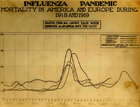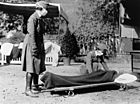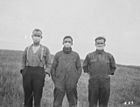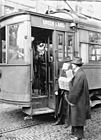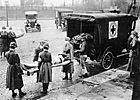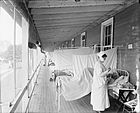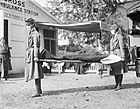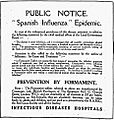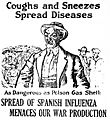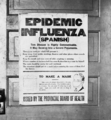Influenza pandemic of 1918 facts for kids
The Influenza pandemic of 1918 or Spanish flu was a serious pandemic of influenza. It lasted for three years, from January 1918 to December 1920. About 500 million people were infected across the world with a population of 1.80 billion people.
The pandemic spread to remote Pacific Islands and the Arctic. It killed 50 million to 100 million people— three to five percent of the world's population at the time.
It was one of the deadliest natural disasters in human history. One of the reasons for that was becuase the pandemic occured before people knew much about viruses, and before anti-viral medications and vaccines. The people would also get secondary infections leading to pneumonia, which in today's world we would treat with antibiotics like penicillin. Unfortunately Penicillin was only discovered in 1928, ten years after the 1918 pandemic.
To maintain morale, wartime censors reduced reports of illness and mortality in Germany, Britain (United Kingdom), France, and the United States; but papers could report the epidemic's effects in neutral Spain (such as the grave illness of King Alfonso XIII). This situation created the false impression of Spain being especially hard-hit. It also resulted in the nickname Spanish flu.
Often, influenza outbreaks kill young people, or the elderly, or those patients that are already weakened. This was not the case for the 1918 pandemic, which killed mainly healthy young adults. Modern research, using virus taken from the bodies of frozen victims, has concluded that the virus kills through a cytokine storm (overreaction of the body's immune system). The strong immune reactions of young adults ravaged the body. But, the weaker immune systems of children and middle-aged adults caused fewer deaths among those groups.
There is not enough historical and epidemiological data to show where the pandemic started. The pandemic may be a cause of the outbreak of encephalitis lethargica in the 1920s. Another flu pandemic had happened in the 21st century that turns out to be new strain of H1N1. The outbreak began in Mexico and then the United States; spread to the world.
Gallery
-
Number of deaths in New York City, Berlin, Paris, and London (Museum of Health & Medicine, Washington), c. 1918–1919
-
Two American Red Cross nurses demonstrated treatment practices during the influenza pandemic of 1918.
-
Albertan farmers wore masks to protect themselves from the flu.
-
Policemen wearing masks provided by the American Red Cross in Seattle, 1918
-
A street car conductor in Seattle in 1918 refusing to allow passengers aboard who are not wearing masks
-
Red Cross workers remove a flu victim in St. Louis, Missouri (1918)
-
Influenza ward at Walter Reed Hospital during the Spanish flu pandemic of 1918–1919
-
Cavalry memorial on the hill Lueg, memory of the Bernese cavalrymen victims of the 1918 flu pandemic; Emmental, Bern, Switzerland
Images for kids
-
Front page of El Sol (Madrid), 28 May 1918: "The three-day fever. 80,000 infected in Madrid. H.M. the king is sick."
-
Advertisement in The Times 28 June 1918 for Formamint tablets to prevent 'Spanish influenza'
-
Edvard Munch (1863–1944), Self-Portrait with the Spanish Flu (1919)
-
Alberta's provincial board of health poster
-
1918 influenza epidemic burial site in Auckland, New Zealand
See also
 In Spanish: Pandemia de gripe de 1918 para niños
In Spanish: Pandemia de gripe de 1918 para niños


